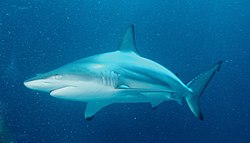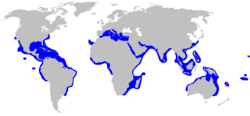カマストガリザメ
出典: フリー百科事典『ウィキペディア(Wikipedia)』 (2022/08/18 07:47 UTC 版)
| カマストガリザメ | |||||||||||||||||||||
|---|---|---|---|---|---|---|---|---|---|---|---|---|---|---|---|---|---|---|---|---|---|

| |||||||||||||||||||||
| 保全状況評価[1] | |||||||||||||||||||||
| VULNERABLE (IUCN Red List Ver.3.1 (2001)) 
| |||||||||||||||||||||
| 分類 | |||||||||||||||||||||
| |||||||||||||||||||||
| 学名 | |||||||||||||||||||||
| Carcharhinus limbatus (Müller & Henle, 1839) | |||||||||||||||||||||
| シノニム | |||||||||||||||||||||
| |||||||||||||||||||||
| 英名 | |||||||||||||||||||||
| Blacktip shark blackfin shark blacktip whaler grey shark spotfin ground shark[2] | |||||||||||||||||||||
 分布
|
素早い魚食性捕食者で、水上に跳び出すこともある。性格は臆病。年齢・性別ごとに群れを作る。胎生で一年おきに1-10匹の仔を産む。幼体は特定の成育場で育ち、成体になってもそこに戻る。無性生殖した例がある。
普通は危険ではないが、餌があると人を攻撃することがある。商業漁業上の重要種である。IUCNは危急としている。
分類
フランスの動物学者アシル・ヴァランシエンヌによって、1839年のヨハネス・ペーター・ミュラーとヤーコプ・ヘンレによるSystematische Beschreibung der PlagiostomenにCarcharias (Prionodon) limbatusとして記載された。タイプ標本はマルティニーク沖から得られた2個体だったが、どちらも失われた。その後この種はCarcharhinus属に移された[3][4]。種小名limbatusはラテン語で「縁取られた」を意味し、鰭にある黒い縁取りに因んだものである[5]。
系統
形態と行動の類似から、Carcharhinus amblyrhynchoides とハナザメに近縁だと考えられていた。mtDNAとリボソームDNAを用いた分子系統解析では、ハナグロザメと近縁だとされた[6]。その後に行われたmtDNAによる包括的な系統解析では、Carcharhinus tilstoni やC. amblyrhynchoides と近縁だという結果が得られている[7]。
また、ミトコンドリアDNAの解析結果からは、この種には2つの系統、西大西洋の系統と東大西洋・インド洋・太平洋の系統が存在することが分かった。これは、東大西洋の系統がインド太平洋に分布を広げる一方、西大西洋の系統は大西洋の拡大・パナマ地峡の形成によって孤立した結果だと見られている。この2つの系統は形態・体色・生活史が異なっており、独立種とすべきかもしれない[8]。化石化した歯がデラウェア州・フロリダ州の前期中新世(23-16Ma)の地層から産出する[9][10]。
- ^ a b Musick, J.A. and Fowler, S. (2000). "Carcharhinus limbatus". IUCN Red List of Threatened Species. Version 2007. International Union for Conservation of Nature. 2009年4月27日閲覧。
- ^ a b c Froese, Rainer and Pauly, Daniel, eds. (2009). "Carcharhinus limbatus" in FishBase. April 2009 version.
- ^ a b c d e f g h i j k l m n o Compagno, L.J.V. (1984). Sharks of the World: An Annotated and Illustrated Catalogue of Shark Species Known to Date. Rome: Food and Agricultural Organization. pp. 481–483. ISBN 9251013845
- ^ a b c d e f Curtis, T. Biological Profiles: Blacktip Shark. Florida Museum of Natural History Ichthyology Department. Retrieved on April 27, 2009.
- ^ a b c d Ebert, D.A. (2003). Sharks, Rays, and Chimaeras of California. London: University of California Press. pp. 156–157. ISBN 0520234847
- ^ Dosay-Akbulut, M. (2008). “The phylogenetic relationship within the genus Carcharhinus”. Comptes Rendus Biologies 331 (7): 500–509. doi:10.1016/j.crvi.2008.04.001. PMID 18558373.
- ^ Naylor, G.J.; Caira, J.N.; Jensen, K.; Rosana, K.A.; Straube, N.; Lakner, C. (2012). “Elasmobranch phylogeny: A mitochondrial estimate based on 595 species”. In Carrier, J.C.; Musick, J.A.; Heithaus, M.R., eds. The Biology of Sharks and Their Relatives (second ed.). CRC Press. pp. 31–57. ISBN 1-4398-3924-7.
- ^ Keeney, D.B. and Heist, E.J. (October 2006). “Worldwide phylogeography of the blacktip shark (Carcharhinus limbatus) inferred from mitochondrial DNA reveals isolation of western Atlantic populations coupled with recent Pacific dispersal”. Molecular Ecology 15 (12): 3669–3679. doi:10.1111/j.1365-294X.2006.03036.x. PMID 17032265.
- ^ Benson. R.N., ed (1998). Geology and Paleontology of the Lower Miocene Pollack Farm Fossil Site, Delaware: Delaware Geological Survey Special Publication No. 21. Delaware Natural History Survey. pp. 133–139
- ^ Brown, R.C. (2008). Florida's Fossils: Guide to Location, Identification, and Enjoyment (third ed.). Pineapple Press Inc. p. 100. ISBN 1561644099
- ^ Martin, R.A. Albinism in Sharks. ReefQuest Centre for Shark Research. Retrieved on April 28, 2009.
- ^ a b c d e Castro, J.I. (November 1996). “Biology of the blacktip shark, Carcharhinus limbatus, off the southeastern United States”. Bulletin of Marine Science 59 (3): 508–522.
- ^ Heupel, M.R. and Simpfendorfer, C.A. (2005). “Quantitative analysis of aggregation behavior in juvenile blacktip sharks”. Marine Biology 147: 1239–1249. doi:10.1007/s00227-005-0004-7.
- ^ Heupel, M.R. and Hueter, R.E. (2002). “The importance of prey density in relation to the movement patterns of juvenile sharks within a coastal nursery area”. Marine and Freshwater Research 53: 543–550. doi:10.1071/MF01132.
- ^ Bullard, S.A., Frasca, A. (Jr.) and Benz, G.W. (June 2000). “Skin Lesions Caused by Dermophthirius penneri (Monogenea: Microbothriidae) on Wild-Caught Blacktip Sharks (Carcharhinus limbatus)”. Journal of Parasitology 86 (3): 618–622. doi:10.1645/0022-3395(2000)086[0618:SLCBDP]2.0.CO;2.
- ^ Bullard, S.A., Benz, G.W. and Braswell, J.S. (2000). “Dionchus postoncomiracidia (Monogenea: Dionchidae) from the skin of blacktip sharks, Carcharhinus limbatus (Carcharhinidae)”. Journal of Parasitology (86): 245–250.
- ^ Rosa-Molinar, E. and Williams, C.S. (1983). “Larval nematodes (Philometridae) in granulomas in ovaries of blacktip sharks, Carcharhinus limbatus (Valenciennes)”. Journal of Wildlife Diseases 19 (3): 275–277. doi:10.7589/0090-3558-19.3.275. PMID 6644926.
- ^ Riner, E.K. and Brijnnschweiler, J.M. (2003). “Do sharksuckers, Echeneis naucrates, induce jump behaviour in blacktip sharks, Carcharhinus limbatus?”. Marine and Freshwater Behaviour and Physiology 36 (2): 111–113. doi:10.1080/1023624031000119584.
- ^ Brunnschweiler, J.M. (2005). “Water-escape velocities in jumping blacktip sharks”. Journal of the Royal Society Interface 2 (4): 389–391. doi:10.1098/rsif.2005.0047. PMC 1578268. PMID 16849197.
- ^ Ritter, E.K. and Godknecht, A.J. (February 1, 2000). Ross, S. T.. ed. “Agonistic Displays in the Blacktip Shark (Carcharhinus limbatus)”. Copeia 2000 (1): 282–284. doi:10.1643/0045-8511(2000)2000[0282:ADITBS]2.0.CO;2.
- ^ a b c Barry, K.P. (2002). Feeding habits of blacktip sharks, Carcharhinus limbatus, and Atlantic sharpnose sharks, Rhizoprionodon terraenovae, in Louisiana coastal waters. MS thesis, Louisiana State University, Baton Rouge.
- ^ Dudley, S.F.J. and Cliff, G. (1993). “Sharks caught in the protective gill nets off Natal, South Africa. 7. The blacktip shark Carcharhinus limbatus (Valenciennes)”. African Journal of Marine Science 13: 237–254.
- ^ a b Keeney, D.B., Heupel, M., Hueter, R.E. and Heist, E.J. (2003). “Genetic heterogeneity among blacktip shark, Carcharhinus limbatus, continental nurseries along the U.S. Atlantic and Gulf of Mexico”. Marine Biology 143: 1039–1046. doi:10.1007/s00227-003-1166-9.
- ^ Bornatowski, H. (2008). “A parturition and nursery area for Carcharhinus limbatus (Elasmobranchii, Carcharhinidae) off the coast of Paraná, Brazil”. Brazilian Journal of Oceanography 56 (4): 317–319.
- ^ Keeney, D.B., Heupel, M.R., Hueter, R.E. and Heist, E.J. (2005). “Microsatellite and mitochondrial DNA analyses of the genetic structure of blacktip shark (Carcharhinus limbatus) nurseries in the northwestern Atlantic, Gulf of Mexico, and Caribbean Sea”. Molecular Ecology 14 (7): 1911–1923. doi:10.1111/j.1365-294X.2005.02549.x. PMID 15910315.
- ^ a b c Capapé, C.H., Seck, A.A., Diatta, Y., Reynaud, C.H., Hemida, F. and Zaouali, J. (2004). “Reproductive biology of the blacktip shark, Carcharhinus limbatus (Chondrichthyes: Carcharhinidae) off West and North African Coasts”. Cybium 28 (4): 275–284.
- ^ Heupel, M.R. and Simpfendorfer, C.A. (2002). “Estimation of mortality of juvenile blacktip sharks, Carcharhinus limbatus, within a nursery area using telemetry data”. Canadian Journal of Fisheries and Aquatic Sciences 59 (4): 624–632. doi:10.1139/f02-036.
- ^ a b c Branstetter, S. (Dec. 9, 1987). “Age and Growth Estimates for Blacktip, Carcharhinus limbatus, and Spinner, C. brevipinna, Sharks from the Northwestern Gulf of Mexico”. Copeia (American Society of Ichthyologists and Herpetologists) 1987 (4): 964–974. doi:10.2307/1445560. JSTOR 1445560.
- ^ a b c d Fowler, S.L., Cavanagh, R.D., Camhi, M., Burgess, G.H., Cailliet, G.M., Fordham, S.V., Simpfendorfer, C.A. and Musick, J.A. (2005). Sharks, Rays and Chimaeras: The Status of the Chondrichthyan Fishes. International Union for Conservation of Nature and Natural Resources. pp. 106–109, 293–295. ISBN 2831707005
- ^ a b Killam, K.A. and Parsons, G.R. (May 1989). “Age and Growth of the Blacktip Shark, Carcharhinus limbatus, near Tampa Bay”. Florida Fishery Bulletin 87: 845–857.
- ^ Wintner, S.P. and Cliff, G. (1996). “Age and growth determination of the blacktip shark, Carcharhinus limbatus, from the east coast of South Africa”. Fishery Bulletin 94 (1): 135–144.
- ^ Chapman, D.D., Firchau, B. and Shivji, M.S. (2008). “Parthenogenesis in a large-bodied requiem shark, the blacktip Carcharhinus limbatus”. Journal of Fish Biology 73: 1473–1477. doi:10.1111/j.1095-8649.2008.02018.x.
- ^ ISAF Statistics on Attacking Species of Shark. International Shark Attack File, Florida Museum of Natural History, University of Florida. Retrieved on April 22, 2009.
- 1 カマストガリザメとは
- 2 カマストガリザメの概要
- 3 形態
- 4 人との関連
- カマストガリザメのページへのリンク